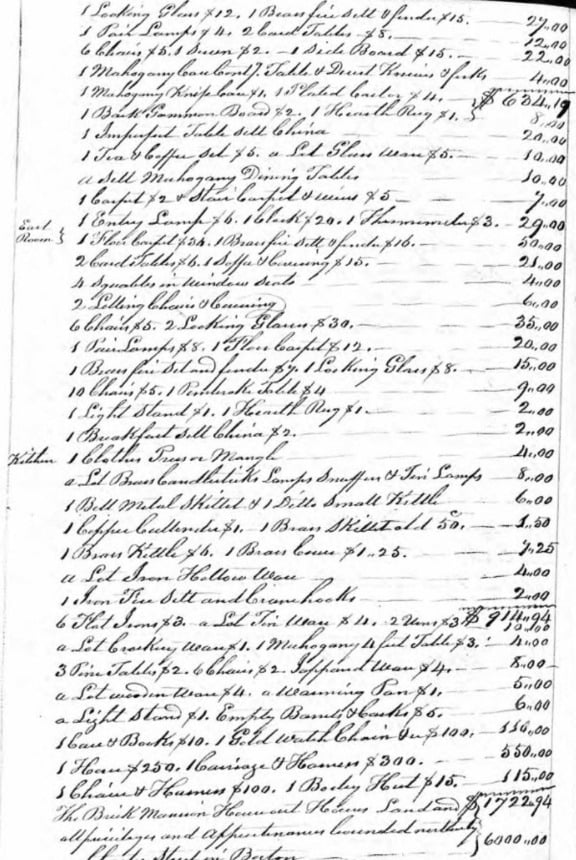
He’s the stuff legends are made of — literally. Paul Revere’s famous ride through the Massachusetts countryside to alert the Patriots that the British were on the move was immortalized in Henry Wadsworth Longfellow’s poem Paul Revere’s Ride. Written in 1860 on the eve of the Civil War, some details in the poem were fictionalized and the two men who accompanied Revere that night were not mentioned, but it served to make the story of that night an inspiring part of American history and won Paul Revere an immortal place in the American pantheon.
Paul Revere was born to French Huguenot immigrant Apollos Rivoire who arrived in Boston at a young age and was apprenticed to Boston goldsmith John Coney. At some point Apollos changed his name to Paul Revere and following Coney’s death in 1722, he was able to purchase his freedom from the remainder of his indenture required under his apprenticeship from the Coney estate.
On June 19, 1729, Apollos, who was by now using his Americanized name of Paul Revere, married Deborah Hitchbourne. Deborah’s father owned a wharf near where Apollos, had been working for Coney.

The couple’s first child was a daughter, Deborah, followed by Paul Jr. who was born on December 21, 1734. The couple went on to have another seven children in the years that followed and the eldest son Paul soon followed in his father’s footsteps working as a gold and silversmith. Paul Sr. died in 1754, leaving his oldest son with the great responsibility of keeping the family afloat, even though by law, he couldn’t own the shop because he wasn’t 21 (the age of majority at the time).
In 1756, when war broke out between the British and the French, Paul, now 22, joined Massachusetts troops and went off to fight in the French and Indian War. When the troops returned to Boston for the winter that year, Paul came home. When the troops once again marched off in the spring, he remained in Boston continuing his career as a master silversmith and the following year he married his first wife, Sarah Orne.
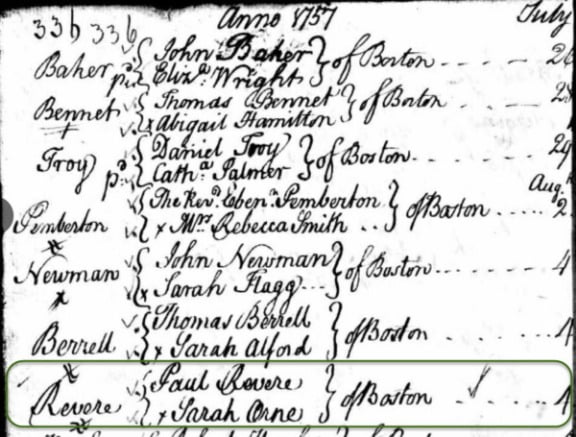
Paul and Sarah had eight children (seven of them girls), but only six lived to adulthood. As the years went by, the Revere business continued to grow and Paul became deeply involved with the local Masonic Lodge of St. Andrews, beginning with his initiation in 1760. A record of his involvement can be found in the collection of Massachusetts, Mason Membership Cards, 1733-1990 on Ancestry.
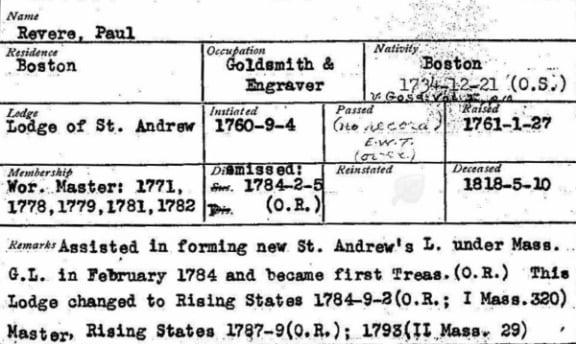

Through the Freemasons he would be in the company of other patriots like John Hancock, Joseph Warren, and James Otis.

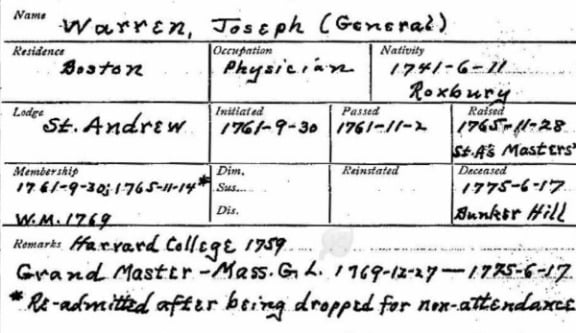
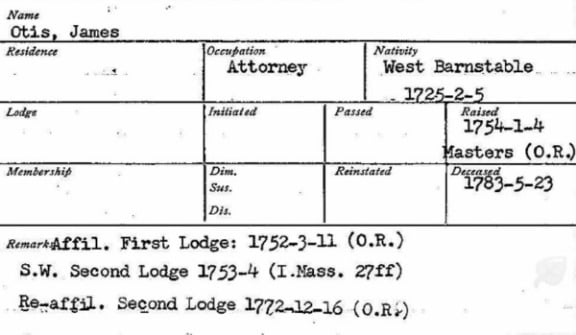
With his involvement with the Freemasons, he also became involved in the activities of the Sons of Liberty. He also used his skills in creating copper engravings to support the Revolutionary movement. His most famous engraving was of the Boston Massacre, entitled The Bloody Massacre perpetrated in King Street, Boston.
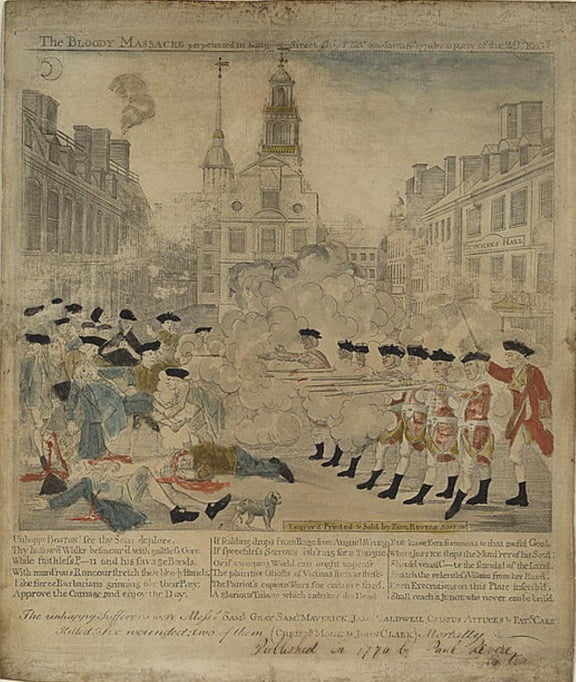
Through propaganda like this, Revere helped swing the tide of public opinion in favor of the Revolutionary cause.
In April of 1773, Paul’s wife, Sarah, after a difficult birth of her eighth child in December 1772, died. The baby, Isanna, was never well and died in September 1773. On October 11, Paul Revere and Rachel Walker were married by Samuel Mather.

![]()
Marriage record of Paul Revere and Rachel Walker on October 11, 1773. (Courtesy: Ancestry)Revere continued his activities with the Sons of Liberties and in December of that same year, he participated in the Boston Tea Party.
With the dawn of the Revolution he made his famous ride on the evening of April 18, 1775. That evening, good friend and fellow Mason, Dr. Joseph Warren sent Revere, along with several other riders to alert locals that the British Regulars were on the move, and to warn Sam Adams and John Hancock that the British might be setting out to arrest them. After leaving Adams and Hancock in Lexington, Revere, along with William Dawes who had also been dispatched to spread the alarm, met up with Samuel Prescott, who joined them en route to Concord. The trio was stopped by a British patrol and while Prescott and Dawes were able to escape, Revere was captured and released the next morning, never completing the trip to Concord that night. Prescott was able to take the alarm to Concord, where munitions were being stored in the arsenal.

During the Revolutionary War, Paul Revere served as an officer in the Massachusetts Militia. In April 1776, he appears on a list of officer appointments as a major and would eventually achieve the rank of colonel. After a failed expedition in Penobscot, Maine, Revere was placed under house arrest, but following a court martial he requested to clear his name, he was exonerated of any wrong-doing.

Following the war, he continued to grow his silver business, and when he was in his sixties, expanded into the copper industry, establishing a rolling mill in Canton, Massachusetts. With the help of his son Joseph Warren Revere, the family’s bell-making business and copper foundry thrived.
Paul Revere died on May 10, 1818. He named his son and business partner, Joseph Warren Revere, as his executor, and he and his sureties were required to post $40,000 bond for the execution of the estate. He appears to have had a fallout with one of his grandsons prior to his death. His last will and testament states, “It is my will that my Grandson Frank who now writes his name Francis Lincoln, eldest son of my late daughter Deborah, shall have no part of my estate except one dollar which is here bequeathed to him.” To add insult to injury, he gave Frank’s $500 share to his brother Frederick.
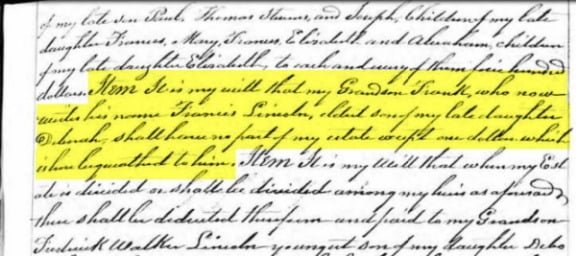
Paul Revere’s will from Massachusetts, Wills and Probates, 1635-1991 on Ancestry. (Courtesy: Ancestry)Fittingly, the inventory of Paul Revere’s estate begins with a list of the silver in his house, and then proceeds to itemize his household possessions, room by room, giving us a tour of his home nearly 200 years after his passing.

